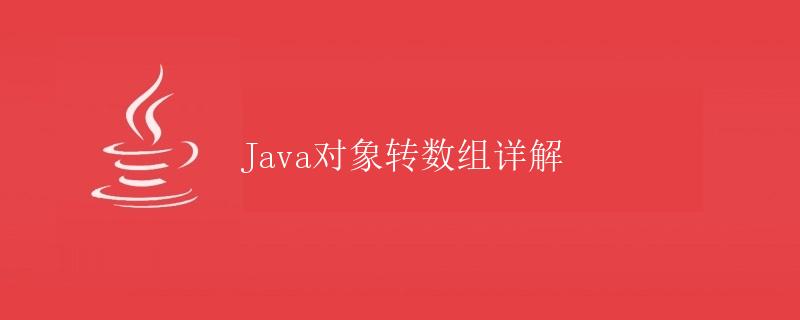Java对象转数组详解

在Java编程中,我们经常会遇到将对象转换为数组的情况。对象和数组是Java中两种不同的数据类型,它们在存储和使用上有着很大的区别。本文将详细讨论如何将Java对象转换为数组,并给出示例代码并解释运行结果。
1. 为什么需要将对象转换为数组
在实际开发中,我们常常需要将一个包含多个对象的集合转换为数组。数组在访问和处理上更加高效,因此将对象转换为数组有助于提高程序的性能。
此外,有些情况下,我们可能需要将对象存储到一个数组中进行某些操作,或者将对象作为方法的参数传递给其他方法。这时,将对象转换为数组可以更方便地进行操作和传递。
2. Java对象转换为数组的方法
Java提供了多种方法来实现对象到数组的转换。我们可以根据实际情况选择合适的方法。
2.1 使用循环遍历转换
最简单的方法是使用循环遍历对象集合,并将每个对象的属性值存储到数组中。下面是一个示例代码:
public class ObjectToArrayExample {
public static void main(String[] args) {
List<Person> personList = new ArrayList<>();
personList.add(new Person("Alice", 25));
personList.add(new Person("Bob", 30));
personList.add(new Person("Carol", 35));
String[] names = new String[personList.size()];
int[] ages = new int[personList.size()];
for (int i = 0; i < personList.size(); i++) {
names[i] = personList.get(i).getName();
ages[i] = personList.get(i).getAge();
}
System.out.println("Names: " + Arrays.toString(names));
System.out.println("Ages: " + Arrays.toString(ages));
}
}
运行结果如下:
Names: [Alice, Bob, Carol]
Ages: [25, 30, 35]
该示例中,我们定义了一个Person类,其中包含name和age两个属性。通过循环遍历personList集合,我们将每个元素的属性值存储到对应的数组中。最后,通过Arrays.toString()方法打印数组的内容。
2.2 使用Java 8的Stream API转换
Java 8引入了Stream API,它提供了一种更简洁的方式来进行集合操作。我们可以使用Stream API来将对象集合中的元素转换为数组。下面是一个示例代码:
public class ObjectToArrayExample {
public static void main(String[] args) {
List<Person> personList = new ArrayList<>();
personList.add(new Person("Alice", 25));
personList.add(new Person("Bob", 30));
personList.add(new Person("Carol", 35));
String[] names = personList.stream()
.map(Person::getName)
.toArray(String[]::new);
System.out.println("Names: " + Arrays.toString(names));
}
}
运行结果与前一个示例相同:
Names: [Alice, Bob, Carol]
在上述示例中,我们使用了Stream的map()方法将每个Person对象映射为它的名称。最后,通过toArray(String[]::new)方法将Stream转换为字符串数组。
2.3 使用Apache Commons Lang库转换
如果你使用Apache Commons Lang库,你可以使用其中的ArrayUtils.toPrimitive()和ArrayUtils.toObject()方法来实现对象与数组之间的转换。下面是一个示例代码:
import org.apache.commons.lang3.ArrayUtils;
public class ObjectToArrayExample {
public static void main(String[] args) {
Integer[] numbers = {1, 2, 3, 4, 5};
int[] primitiveNumbers = ArrayUtils.toPrimitive(numbers);
Integer[] objectNumbers = ArrayUtils.toObject(primitiveNumbers);
System.out.println("Primitive numbers: " + Arrays.toString(primitiveNumbers));
System.out.println("Object numbers: " + Arrays.toString(objectNumbers));
}
}
运行结果如下:
Primitive numbers: [1, 2, 3, 4, 5]
Object numbers: [1, 2, 3, 4, 5]
在上述示例中,我们首先将Integer类型的数组转换为原始类型(int)数组,然后再将原始类型数组转换回Integer类型数组。
3. 总结
本文详细讨论了如何将Java对象转换为数组,并给出了多种实现方法的示例代码。通过将对象转换为数组,我们可以提高程序的性能,并方便地进行操作和传递。在实际开发中,我们可以根据具体需求选择合适的方法来进行对象到数组的转换。
 极客教程
极客教程